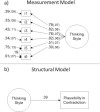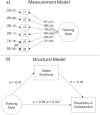Individual differences in thinking style and dealing with contradiction: The mediating role of mixed emotions
- PMID: 34559841
- PMCID: PMC8462706
- DOI: 10.1371/journal.pone.0257864
Individual differences in thinking style and dealing with contradiction: The mediating role of mixed emotions
Abstract
The present research examined how individuals' thinking style (holistic vs. analytic) is associated with the way they deal with contradictory information and whether experiencing mixed emotions can mediate this relationship. Participants first completed the thinking style measure and then were exposed to two contradictory pieces of information (Studies 1 and 2). In study 2, we also measured the experience of mixed emotions to test the mediating role of this variable. Across two studies, we found that individuals with a holistic thinking style were more able to reconcile contradictory information compared to individuals with an analytic thinking style. Study 2 showed that the relationship between thinking style and dealing with contradiction was mediated by the experience of mixed emotions. This research extends previous findings on confrontation of contradiction and mixed emotions by using an individual-differences rather than a cultural-differences approach, and establishes mixed emotions as a plausible mediating variable.
Conflict of interest statement
The authors have declared that no competing interests exist.
Figures


References
-
- Hou Y, Zhu Y, Peng K. Thinking style and disease cognitions among Chinese people. Journal of Psychology in Chinese Societies. 2003;4(2):161–80.
-
- Wong YJ, Liu T. Dialecticism and mental health: Toward a yin-yang vision of well-being. In: Spencer-Rodgers J, Peng K, editors. Oxford University Press; 2018. p. 547–572.
-
- Brannon SM, Gawronski B. Cognitive consistency in social cognition. In: Hogg M, editor. The Oxford encyclopedia of social psychology. New York: Oxford University Press; 2018.
-
- Harmon-Jones E, Harmon-Jones C, Levy N. An action-based model of cognitive-dissonance processes. Curr Dir Psychol Sci. 2015Jun;24(3):184–9.
-
- Kelly RE, Mansell W, Wood AM. Goal conflict and well-being: A review and hierarchical model of goal conflict, ambivalence, self-discrepancy and self-concordance. Pers Individ Dif. 2015Oct1;85:212–29.
MeSH terms
LinkOut - more resources
Full Text Sources

